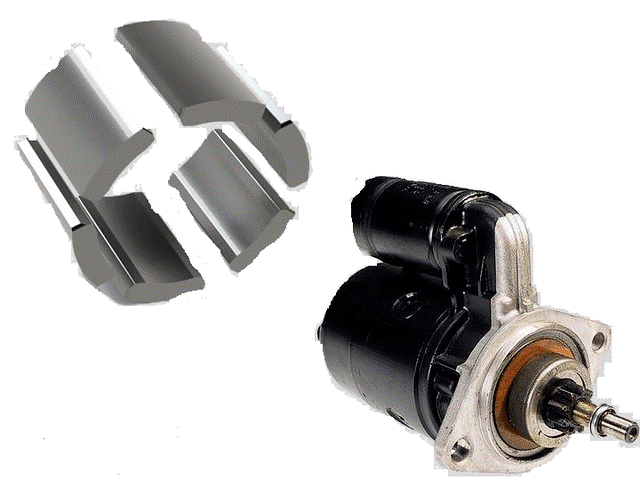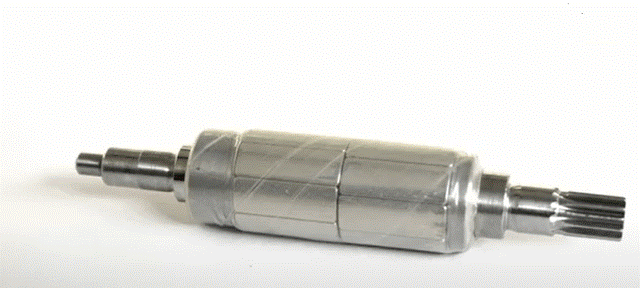How to Protect the Ability of Brushless Magnets Motor?
In recent years, the use of brushless motors has grown exponentially in the motor field as they are smaller in size, can provide ferrite equivalent torque, consume less power, have higher speeds, require less maintenance, dissipate heat better, and can be overloaded.

One of the most critical problems of such surface permanent magnet motors is the complexity of fixing the NdFeB magnets to the rotor, the fragility of the NdFeB magnets cannot be welded to the rotor and the permanent magnets suffer irreversible loss of flux (Curie points) at high temperatures.
How to protect the ability of brushless motor magnets?
Multilayer heat shrink tubing with high mechanical resistance and high thermal coefficient used to hold and protect the brushless motor rotor, balances all types of centrifugal forces exerted on the permanent magnets.

There is no risk of cracking or damaging the precision permanent magnets during assembly. It has the advantage of perfect bonding even at the edges of the rotor. In addition, the glass fibers inside the heat shrink sleeve are also extremely mechanically strong and temperature resistant, and the temperature used for heat shrinkage is well below the Curie point without reducing the flux of the magnet.
By inserting the heat shrink sleeve into the rotor, seating the magnet, and heat shrinking it (by using a much lower temperature than the Curie point and avoiding any risk of loss of flux), strong adhesion is obtained even at high speeds. It also resists the thermal shock generated by the motor during long runs (up to 180°C). Eddy current losses, which reduce motor efficiency and can lead to motor overheating, are avoided compared to very expensive metal rotor sleeves.
Thanks to its limited thickness range between 0.19 and 0.35 mm, the sleeve ensures the optimum correct flux of the permanent magnets and the best performance of the magnets, thus ensuring the best performance of the motor itself.
Other important advantages offered by heat shrink tubing, include: Unlike very expensive steel rings, heat shrink tubing wraps around and protects the ends of the magnets, which are also susceptible to corrosion and can cause the motor to jam if broken.
Avoiding trimming during assembly with rigid rings, the heat shrink tubing adheres perfectly to the magnet, has a certain shape, and prevents it from breaking and scratching. If the magnets are glued in the proper position on the rotor, depending on the amount of glue used for each magnet, there may be some problems with the balance of the rotor, which means installing some complicated systems to balance the rotor, thus increasing the scrap rate.
With round heat shrink tubing, rotor balancing can be easily achieved, reducing production scrap rates. Part of the balancing inspection of the assembly process can be eliminated, eliminating potentially high costs, eliminating the need for a manual taping with epoxy-impregnated tape, and avoiding slow resin activation times in the oven, thus increasing productivity and reducing hidden production costs.
Heat shrink tubing can also be used successfully in conjunction with the epoxy resin adhesive used to hold the magnets in place, thus ensuring additional protection against potential glue failure and magnet dislodgement, as well as against scratches or other contaminants.
Conclusion
In motors using ring magnets made by compression molding of NdFeB magnets with the addition of thermosetting resin (plastic ferrite), the heat shrinkable tubing also protects the magnets from corrosion and thus prevents the motor from jamming, given the brittle nature of the alloy used.
The heat-shrinkable polyester tubing also guarantees adiabatic (class B), dielectric (4 -5 kV) insulation, and use at temperatures of up to 150 -155°C peak. Quick and easy positioning of the thickness, size, and weight of the permanent magnets in automated industrial processes facilitates perfect adhesion of the heat shrinkable tube to the rotor and magnets, and the recovery of the permanent magnets process achieves low cost and easy disassembly.
